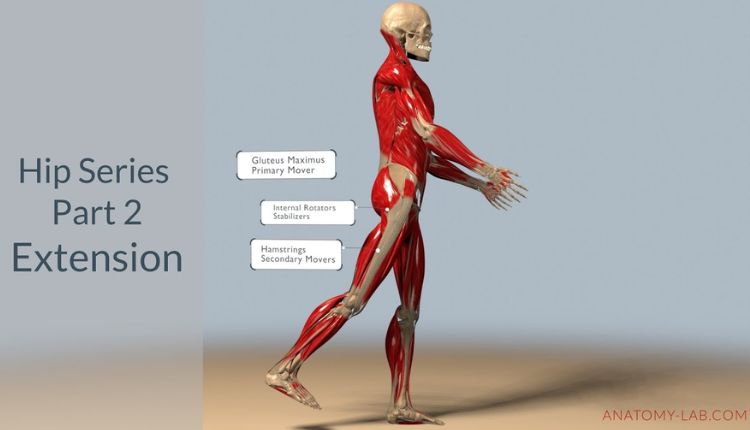Hip extension plays a key role in upright movement, from walking and running to rising from a chair. The motion—posterior movement of the thigh relative to the pelvis—relies on coordinated action among several muscle groups, particularly the gluteus maximus, the hamstrings and the adductor magnus. Strength coach Bret Contreras and other practitioners emphasize that effective hip extension supports everyday function and athletic performance. Proper mechanics can improve movement efficiency and may help distribute load across the posterior chain, potentially reducing stress on the lower back and knees.
Efficient, controlled hip extension influences functional capacity and athletic output. It is a foundational pattern in physical therapy and strength training. Understanding the mechanical and neural control of hip extension helps explain why deficits in this motion often coincide with broader biomechanical issues.
Mechanics of hip extension
Hip extension occurs primarily at the hip joint as the femur moves backward in the sagittal plane. The pelvis should remain relatively stable as the leg drives behind the body. The gluteus maximus is the prime mover, with assistance from the hamstrings and the posterior fibers of the adductor magnus.
When performed well, hip extension helps maintain trunk–pelvis alignment, limits compensatory lumbar extension and supports force transfer through the lower limbs. It underpins gait, jumping, lifting and climbing. Limited range of motion or poor control can disrupt these patterns and shift stress to other joints, including the knees and lower back.
Muscle contributions and coordination
The gluteus maximus is the most powerful hip extensor and is especially active in high-force tasks such as sprinting or rising from a deep squat. The hamstrings act as biarticular muscles that extend the hip and flex the knee. These muscles must coordinate to produce efficient, forceful movement.
Electromyography studies show that when the gluteus maximus underperforms, the hamstrings and lumbar extensors often compensate. Over time, that pattern can be associated with overuse symptoms, fatigue and kinetic-chain imbalances. Coaches and clinicians frequently assess recruitment timing and strength during hip extension to identify such deficits.
Role in gait and running
In walking, hip extension ramps up in late stance while the foot is still on the ground. The gluteals and hamstrings drive the thigh backward and set up the leg for swing, contributing to propulsion and an efficient stride.
Running demands greater range and higher forces. The contribution of the gluteus maximus becomes more pronounced, aiding propulsion and trunk control. Research links limited hip extension capacity with shorter stride length and reduced running economy, though performance is multifactorial.
Applications in strength training
Hip extension anchors many strength movements. Romanian deadlifts, hip thrusts, kettlebell swings and barbell glute bridges train extension under load. These exercises target the posterior chain and are used in injury prevention, rehabilitation and performance programs.
In strength and conditioning, coaches program hip-extension work to build force production, coordination and patterns that carry into sport skills. Practitioners such as Bret Contreras emphasize that strong, well-timed hip drive supports spine stability and efficient load carriage, with system-wide benefits when the glutes are doing their job.
Limitations and compensation patterns
When hip extension is restricted by mobility or neuromuscular control, the body often compensates. Common patterns include lumbar hyperextension, anterior pelvic tilt and overreliance on the hamstrings.
These compensations may be subtle but can, over time, contribute to postural changes, chronic lower-back discomfort and inefficiency. Movement assessments—active range-of-motion testing, single-leg bridges and gait analysis—help identify limitations and guide corrective programming.
Relevance in rehabilitation
Restoring effective hip extension is a frequent goal in treating conditions that involve the spine, pelvis or lower limbs. Patients recovering from hip surgery, lumbar issues or neurological impairments may need to relearn extension mechanics.
Therapists use isolated activation drills, resisted hip movements and cue-based motor retraining to prioritize the gluteus maximus as the primary mover. Even modest gains in hip-extension strength and control are associated with improvements in balance, stair climbing and walking endurance.
Aging and functional independence
Aging often brings posterior-chain strength decline, including in the glutes. Reduced hip-extension capacity can impair sit-to-stand and stair climbing. Fall risk rises when hip extensors cannot adequately support the trunk during forward movement.
Interventions that build hip-extension strength have been shown to improve gait speed and reduce fall risk in older adults. Simple, scalable work—banded bridges, hip hinges and modified deadlifts—can help maintain function.
Athletic performance considerations
Across field, court and strength sports, powerful, coordinated hip extension underlies acceleration, deceleration and changes of direction. In Olympic lifts and plyometrics, extension drives vertical power and bar velocity.
Performance programs commonly include resisted sprints, sled pushes and explosive hip-thrust variations to reinforce extension mechanics in sport-specific contexts. These drills train strength as well as timing and joint sequencing to improve transfer to performance.
Hip extension is more than a joint motion; it is a fundamental action that supports posture, propulsion and stability. In rehab and high-performance settings, developing and maintaining effective hip extension can help reduce injury risk and improve function across ages and activities.

